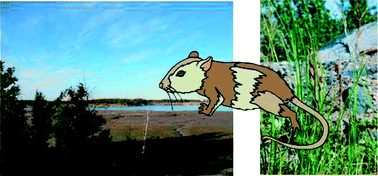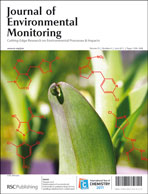Arsenic in terrestrial contaminated sites has the potential to cause harm to residential wildlife. The aim of this study was to determine the arsenic species in wild rodents living in arsenic contaminated habitats, specifically deer mice from Yellowknife, NT and meadow voles from Seal Harbour, NS, along with co-located plants. Methanol : water (1 : 1) extractions were used to optimize the extraction of methylated arsenic(V) species. Total arsenic concentrations were substantially higher in the Yellowknife deer mice (1.7–3.2 µg kg−1 wet weight in livers) and Seal Harbour meadow voles (0.67–0.97 µg kg−1 wet weight in livers) living on the contaminated sites with respect to the surrounding background locations (0.12–0.34 µg kg−1 wet weight in livers). Around 50% of arsenic could be identified in Yellowknife deer mouse tissues, but only <10% was identified in Seal Harbour vole tissues; inorganic arsenic (III and V) and dimethylarsinic acid were all found. Monomethylarsonic acid was only detected in both the mice and voles living in the contaminated sites. In the Yellowknife food chain, methyl arsenic (V) proportions increased from plants to mouse inner organs, but the trend was not for clear as the Seal Harbour food chain. Seal Harbour voles may be sequestering arsenic in a less mobile form, rather than transforming it.

You have access to this article
 Please wait while we load your content...
Something went wrong. Try again?
Please wait while we load your content...
Something went wrong. Try again?


 Please wait while we load your content...
Please wait while we load your content...